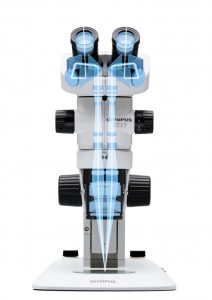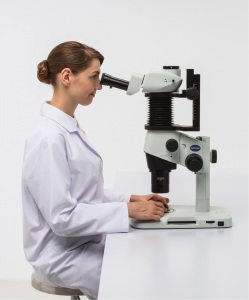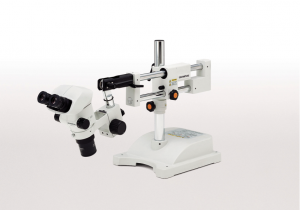When and why a stereo microscope is your ideal choice
Every day, new technology creates smaller and smaller materials—so why would you need a stereo microscope? We sometimes focus on looking at extremely small items that could be only a few microns in size and 1000X or more in magnification is needed, but many times we are looking at something millimeters in size and 10X–50X is more than enough magnification to do the job.
The Benefits of Stereo Optics In Production Scenarios
Let’s first look at the stereo aspect. We all know that our brains interpret three dimensions by using our two eyes and processing the differences between what each eye sees. Why would you want to give this up? Many stereo microscopes utilize Galilean optics, two independent and parallel optical paths that are focused through a single objective to a focal point on your sample to provide the same different angle to each eye, thus the same stereo effect.
 |
| Figure 1: Galilean optics as seen in the Olympus SZX7 stereo microscope. |
Why is this so important? When working under the microscope our hand-eye coordination critically needs that three-dimensional depth for us to put our hands and tools in the correct location. We see this significantly in the world of medical device manufacturers, production areas with 25 or more personnel working under stereo microscopes to assemble and adjust products that help to keep us alive. Products like pacemakers and artificial heart valves require that hands-on touch for perfect construction, but our eyes are the weak point. Stereo microscopes make up that difference. We also see this in electronics and many other fields. In electronics, specifically, many operators are soldering small electrical connections that are close together and could easily short to each other—magnification and depth are critical here as well.
Larger Working Distances Enable Viewing of Bigger Samples
Another advantage to stereo microscopes is the large working distances. Working distance is how far your sample is from the objective lens when properly in focus; with some manufacturers having fairly large components, it is nice to have three to four inches of space between the lens and your sample. This distance does vary by the objective magnification but a working distance of over six inches can be achieved provided the magnification is within your needs. This working distance also helps when trying to look into a void—the area in focus can be down a few inches but the top of the sample does not impact your objective lens.
One more example of when a stereo microscope is ideal is large components with detailed inspection; we see this with welds in the automotive industry. Welds in car body panels are in many locations, and how well these welds hold up is in the details. Samples are taken from the production line and cross-sectioned through the weld. Looking at how far the weld penetrates into the metal is one aspect, but tiny voids in the weld itself can show the potential for a future stress failure.
A Versatile, Ergonomic Observation Solution
Many other aspects make working under a stereo microscope the correct choice for the job. Numerous ergonomic improvements have been made, enabling reduced stress and better posture while working at the microscope for several hours. LED lighting can provide brighter illumination with less heat and longer bulb life. Various microscope stand options allow you to mount your microscope in unlimited variations to look at your sample from any angle. All these aspects make working under a stereo microscope a great solution for your observation needs.
 |
| Figure 2: Ergonomic enhancements to stereo microscopes allow proper posture and comfortable viewing for extended periods of time. |
 |
| Figure 3: Versatile microscope stands allow a stereo microscope to be mounted in unlimited positions. |
Get In Touch
.jpg?rev=6CE9)